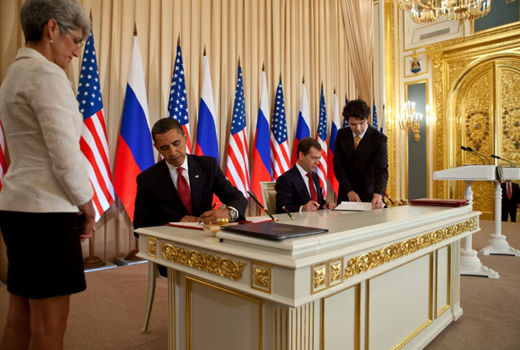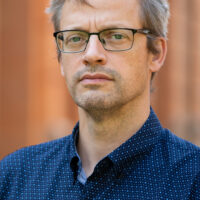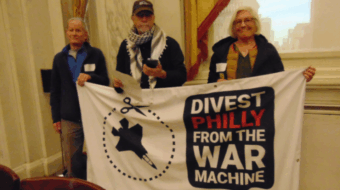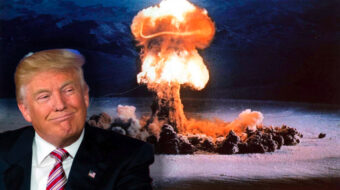
U.S. President Barack Obama and Russian President Dmitry Medvedev in Prague, April 8, signed a new Strategic Arms Reduction Treaty to cut nuclear weapons. The signing of the treaty has been hailed by peace and arms control advocates and faith-based organizations as a good first step toward the abolition of nuclear weapons.
According to a White House fact sheet, the new treaty reduces the number of deployed nuclear weapons by an additional 30 percent over the number agreed upon in the 2002 Moscow Treaty between Russia and the U.S. This provision begins to reduce the number of nuclear weapons to 1,550 starting within seven years. In addition, the agreement would limit to 800 the number of missile launchers and bombers equipped with nuclear weapons.
The new START would also expand the verification and inspection process, the White House reported.
In remarks at the signing of the treaty, President Obama linked the agreement to strengthening the Nuclear Non-Proliferation Treaty and gaining Russian cooperation on international security issues. He described the new START agreement as part of keeping his pledge to reset relations with Russia after years of neglect and hostility by the Bush administration.
“The pursuit of peace and calm and cooperation among nations is the work of both leaders and peoples in the 21st century,” President Obama said. “For we must be as persistent and passionate in our pursuit of progress as any who would stand in our way.”
In the “START Resource Center” on its website, the Center for Arms Control and Non-Proliferation welcome the signing of the agreement. “New START is a modest but critically important and necessary step that enhances U.S. security and reduces the dangers posed by nuclear weapons,” the website stated.
In a press statement, National Council of Churches General Secretary Rev. Dr Michael Kinnamon praised the signing of the agreement and asserted that “the governments of the world must now commit themselves to the complete elimination of nuclear weapons as soon as possible.” The church organization has opposed nuclear weapons since the dropping of the atomic bombs on Japan in 1945.
Peace Action Executive Director Kevin Martin described the new START as “a modest, but good step toward reducing the threat from nuclear weapons.” He urged swift ratification by the Senate, but added that more could be done to bring the country closer to the President’s stated goal of seeking a nuclear weapons free world. “President Obama should continue his push for a nuclear weapons-free world not by beginning another round of negotiations for a further incremental cut to 1,000 nuclear weapons on each side, as has been reported, but by taking executive actions to reduce the U.S. nuclear stockpile,” he said.
“Fewer nuclear weapons makes Americans safer and sends the right message to the rest of the world,” he explained.
The finalized treaty is scheduled to head to the Senate for ratification later this spring, where the Obama administration expects swift action. In a statement, Secretary of State Hillary Clinton said, “I believe that a vast majority of the Senate at the end of the day will see that this is in America’s interest and it goes way beyond politics.”
The past three nuclear arms reduction agreements with Russia (2002, 1996, 1992) passed in the Senate either unanimously or with only a handful of “no” votes.
At a rally in Minnesota earlier this week, Rep. Michele Bachman, R-Minn., known for her ties to the tea party movement, denounced the treaty and seemed to insist that the U.S. government should be ready to use nuclear weapons against non-nuclear states and as retaliation to cyber attacks.
A number of Senate Republicans, including Sen. Richard Lugar, R-Ind., have already expressed support for the treaty.
The treaty must be approved by two-thirds of the Senate for final ratification.
Photo: White House









